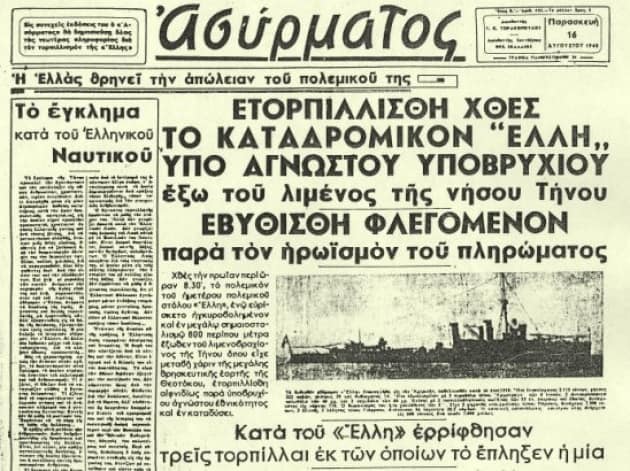It was August 15, 1940, and thousands of Greek Orthodox faithful were assembled at the Church of Panagia on Tinos Island to honour the Dormition of the Virgin Mary as they did every year.
Nevertheless, on that date, an undercover mission by the Italian submarine ‘Delfino’ torpedoed and sank the Greek light cruiser ‘Elli‘ at Tinos’ port.
World War II had been raging for almost a year in Europe, with Greece maintaining a neutral stance, even though dictator Ioannis Metaxas and the Palace were peacefully on the side of Great Britain, which at the time was heavily tested by the Luftwaffe’s aerial bombing campaign.
Fascist Italy, Nazi Germany’s ally, with its powerful fleet, claimed the Mediterranean seas from Great Britain. The order for the torpedoing of ‘Elli’ was given by Italian Dodecanese Chancellor Cesare Maria de Vecchi, a prominent Fascist.
The Italian submarine ‘Delfino’, commanded by Lt. Gen. Giuseppe Aicardi, started from the naval base in Partheni, Leros, on the night of Aug. 14, with the mission to hit enemy ships on Tinos, Syros and then block the Corinth Canal.
On the morning of Aug. 15, the submarine approached the port of Tinos, aiming to torpedo the passenger ships ‘Elsi’ and ‘Esperos’ carrying pilgrims, but the Italians considered them to be carrying troops.
From the perimeter, Aicardi saw the Greek warship in the port and decided that should be the first target, as he admitted after the war. ‘Elli’ had docked on Tinos to participate in the religious celebration.

At 8.25 a.m., just before the procession of the Virgin Mary icon at the port, thousands of people were waiting piously. At that moment, ‘Delfino’ fired three torpedoes at the Greek warship. Only one of the three torpedoes hit ‘Elli’ in the engine room and the oil tanks. An hour later, ‘Elli’ sank, despite the crew’s efforts to keep it afloat.
The other two torpedoes missed their target and exploded on the quay. The one that hit the Greek warship killed a junior officer, eight seamen and injured 24. One woman at the port died of a heart attack after the second torpedo exploded on the waterfront.
After completing its mission, the ‘Delfino’ sailed away, its identity still unknown. After a few hours, it reached Syros but immediately departed as no ship was in the port. Then the submarine returned promptly to Leros by order of the Italian authorities. Foreign Minister Galeatso Ciano wrote in his memoirs that the sinking of the Greek ship was attributed to the megalomania of de Vecchi himself.
The investigation carried out by Navy divers showed that the torpedoes were Italian, so the attack was carried out by an Italian submarine. The Metaxa government kept the result of the investigation completely secret so as not to provoke Italy and disrupt the neutrality of Greece. Finally, it was made public on October 30, 1940, two days after the Italian attack on Greece.
Eventually, the investigation report was released on Oct. 30, 1940, two days after the Italian attack on Greece. Nevertheless, the Greek public did not doubt the submarine’s origin from the beginning.
In 1950, in the context of war reparations, Italy granted Greece the ‘Eugenio Di Savoia’ light cruiser, which was renamed ‘Elli’ in June 1951 and hoisted the blue and white flag. In the mid-1950s, the ‘Elli’ wreckage was partially dismantled and sold for scrap.
The Delfino hurried back to Leros by order of the Italian authorities, cancelling its mission in Corinth.
In 1985, Greek divers discovered at the bottom of Tinos the remnants of the Italian torpedo that sank ‘Elli’. The find is exhibited at the Piraeus Maritime Museum.
The sinking of ‘Elli’ was the precursor of Greece’s eventual involvement in World War II. Italians expected Greece to be afraid to fight against the Axis forces and surrender.
However, the 1940 Greek – Italian war in the Epirus and Albania mountains was a triumph not only of the Greek army but of the Greek spirit as well. The enemy was humiliated to the point that Nazi Germany was forced to send valuable forces to occupy Greece instead of sending them to the Soviet Union front.
In 1950, as part of the war reparations, Italy granted Greece the light cruiser “Eugenio Di Savoia”, renamed “Elli” in June 1951, and had a raised Greek flag.


